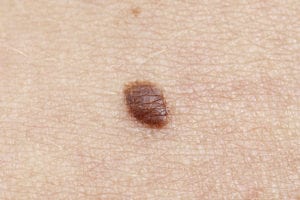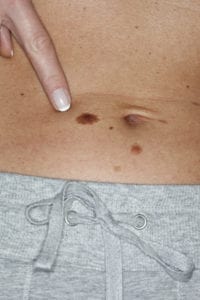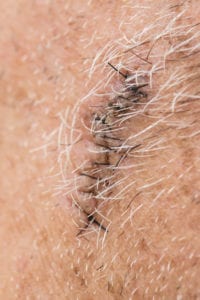Basal Cell Carcinoma FAQs
What is basal cell carcinoma? »
 Basal cell carcinoma is the most common type of skin cancer and the most frequently occurring of all cancers. Eight out of every 10 skin cancers are basal cell carcinomas, making this form of skin cancer far and away from the most common. They grow in the lowest layer of the epidermis, the basal cell layer. These cancers usually develop in sun-exposed areas, especially the head and neck. They tend to grow slowly and it is rare that they spread to other parts of the body. If left untreated, basal cell carcinomas can grow into nearby areas and invade bone or other tissues beneath the skin, making removal potentially disfiguring.
Basal cell carcinoma is the most common type of skin cancer and the most frequently occurring of all cancers. Eight out of every 10 skin cancers are basal cell carcinomas, making this form of skin cancer far and away from the most common. They grow in the lowest layer of the epidermis, the basal cell layer. These cancers usually develop in sun-exposed areas, especially the head and neck. They tend to grow slowly and it is rare that they spread to other parts of the body. If left untreated, basal cell carcinomas can grow into nearby areas and invade bone or other tissues beneath the skin, making removal potentially disfiguring.
How To Identify Basal Cell Carcinoma? »
Basal cell carcinomas look like flesh-colored, pearl-like bumps or pinkish patches of skin. They can develop into sores. They tend to grow most often on areas of the skin that are exposed to the sun, such as your arms, face, and neck. Often the first detected symptom of a basal cell carcinoma is a bleeding spot without a preceding cause. It is extremely rare to see regional spread or metastasis to other locations in the body. However, if left untreated, the lesion will expand and destroy more tissue locally where it is found.
What does basal cell carcinoma look like? »
When the DNA in the basal cells is damaged and a basal cell carcinoma develops, it will appear as a change in the skin, such as a growth or sore that won’t heal. The lesion will have one of the following characteristics. It will look like…

- A pearly white, skin-colored, or pink bump on the skin. It will be translucent, meaning you can see through it slightly, and you can often see blood vessels in it.
- A brown, black, or blue lesion or a lesion with dark spots. It will have a slightly raised, translucent border.
- A flat, scaly, reddish patch of skin with a raised edge. These will occur more commonly on the back or chest.
- A white, waxy, scar-like lesion without a clearly defined border. This “morpheaform” basal cell carcinoma is the least common.
What causes basal cell carcinoma? »
Basal cell carcinoma occurs when one of the skin’s basal cells develops a mutation in its DNA. Basal cells are responsible for producing new skin cells. As they do so, older skin cells are pushed toward the skin surface, where they die and are sloughed off. DNA in the basal cell controls this function.
What Occurs during dNA Mutation? »
When the DNA mutates, things change. The mutation causes a basal cell to multiply rapidly, and they continue growing when normally they would die and be shed. Eventually, the accumulating abnormal cells form a cancerous tumor that shows as a lesion on the surface skin.
Symptoms of Basal Cell Carcinoma »
A basal cell carcinoma will show itself as a change in the skin. It can appear as a pearly white, skin-colored, or pink bump that is somewhat translucent. It can also be a brown, black, or blue lesion with slightly raised borders. On the back or chest, a flat, scaly, reddish patch is more common.
Are there different types of basal cell carcinomas? »
There aren’t really different types, per se, but different lesions can have different appearances. The DNA mutation that occurs in the basal cells is the same with all of these carcinomas, but different people with different skin types can form lesions with different appearances as described above.
Where can it develop? »
Basal cell carcinomas invariably develop on areas that receive lots of sun exposure. They are typically on the head, neck, and arms. Basal cell growths can form on the shoulders but are less frequent on the lower trunk and the legs.
Can basal cell carcinoma turn into melanoma? »
 Basal cell carcinomas cannot progress or turn into melanoma. Basal cell carcinoma forms in the basal cells in the epidermis. They occur when DNA in the cells is damaged by exposure to ultraviolet radiation from the sun or tanning beds. This triggers changes in basal cells in the outermost layer of the skin, resulting in uncontrolled growth. This is a basal cell carcinoma.
Basal cell carcinomas cannot progress or turn into melanoma. Basal cell carcinoma forms in the basal cells in the epidermis. They occur when DNA in the cells is damaged by exposure to ultraviolet radiation from the sun or tanning beds. This triggers changes in basal cells in the outermost layer of the skin, resulting in uncontrolled growth. This is a basal cell carcinoma.
Melanoma begins in cells known as melanocytes. While they are also found in the epidermis, melanocytes are different than basal cells. Melanocytes produce a pigment, known as melanin, which gives the skin its color. When the skin is exposed to UV radiation, it causes skin damage that triggers the melanocytes to produce more melanin. This tanning of the skin is a protective mechanism. But when the burning of the skin causes DNA damage, mutations in the melanocytes result in uncontrolled cellular growth, melanoma.
How dangerous is a basal cell carcinoma? »
While melanoma rightly deserves the attention it receives as the most dangerous form of skin cancer, basal cell carcinoma isn’t something to brush off as harmless. Yes, this most common form of skin cancer rarely causes fatalities, but it can become quite disfiguring.
While basal cell carcinoma lesions rarely spread beyond the original tumor site, they should not be allowed to grow freely. These lesions can grow widely, penetrating deeply into the skin destroying skin, tissue, and bone. Plus, the longer you leave a basal cell carcinoma untreated, the more likely it is to come back. And because it will usually return in the same area, this can create problems removing the lesions without overly disfiguring the patient.
How are basal cell carcinomas treated? »
How we treat your basal cell carcinoma will often be dictated by its location. There are numerous treatment options.
Surgery is the typical treatment method. Depending on the size and location of the removed growth, the wound may be sutured closed, covered with a skin graft, or allowed to heal on its own.
These are the surgical procedures:
Electrodesiccation and curettage
With small or superficial basal cell growths, we remove the surface of the skin cancer with a blade, or often a scraping instrument is known as a curette. Then the base of the cancer is seared with an electric needle. This both closes off blood vessels and kills any stray cancer cells. In some cases, the underlying area is frozen with liquid nitrogen, rather than cauterized with electricity.
Surgical excision
 This involves cutting out the cancerous lesion with a scalpel, along with a margin of healthy skin around it. The sample is then sent to a lab to confirm that removal was successful.
This involves cutting out the cancerous lesion with a scalpel, along with a margin of healthy skin around it. The sample is then sent to a lab to confirm that removal was successful.
Cryosurgery
Spraying liquid nitrogen onto growths is the preferred method for removing precancerous actinic keratoses, but it can also be used on very thin basal cell carcinomas with little depth. The problem with this method is that the freezing time may need to be prolonged, which can possibly damage nerves in the area.
Mohs surgery
This method has the highest success rate of removing all of the basal cell growth. Your surgeon removes the basal cell cancer layer by layer. After a layer is removed, it is examined immediately to check for any remaining cancer cells on the borders. If cancer cells are still found, another layer or ring is removed. This process is continued until the sample shows itself to be clean. This is especially effective for removing growths on the face, as only the minimum amount of tissue is removed.
Basal Cell Carcinomas Topical Treatment
Topical treatments can be successful on superficial basal cell carcinomas with little depth. These drugs work by inflaming the area where they are applied. The body responds by sending white blood cells to attack the inflammation. These white blood cells go after the mutated basal cells. Aldara, Efudex, and Fluoroplex are three of the most used drugs.
How Successful Is Basal Cell Carcinoma Treatment? »
Mohs micrographic surgery has the best cure rates with basal cell carcinoma, a 99 percent cure rate for carcinomas that are not returning growths. The cure rate when basal cell carcinomas are removed with wide excision can be as high as 98 percent. With curettage and electrodesiccation, the rate is from 91 to 97 percent.
Basal cell carcinoma is not considered life-threatening in almost all cases. It is simply disfiguring.
Can you die from basal cell carcinoma? »
Death from either basal cell or squamous cell cancers is quite rare. Statistics for these types of skin cancer aren’t tracked by cancer registries, so it’s difficult to have specific numbers, but it’s thought that less than 2,000 people in the U.S. die from both basal cell and squamous cell carcinomas each year.
These deaths are predominantly in elderly people who have not had their skin checked in a long time and cancer has grown quite large.
Considering there are over 4 million diagnosed cases of basal cell carcinoma each year in the U.S. (along with umpteen undiagnosed), the risk of death from this form of skin cancer is quite low.
What happens if I don’t have a basal cell carcinoma treated? »
As mentioned above, basal cell carcinomas are almost never fatal, but they can be highly disfiguring if left to grow unimpeded. These lesions will grow wider and will penetrate more deeply into the skin, damaging underlying tissue and eventually bone. Removing these growths once they have become so established will involve removing much more surrounding tissue and possibly bone, which can be quite challenging if the growth is on an area such as the face.
Another thing about leaving a basal cell carcinoma untreated is that by doing so you are increasing the odds it will return even if it is removed at this point. Now you’ll have extra future costs of excision or another removal, along with more tissue loss.
None of this should happen. When basal cell carcinoma is diagnosed early on, removing the lesion is usually quite simple and the success rate is very high. If addressed early, it’s unlikely another basal cell carcinoma will return to that location, as well.
What Is Moh’s Surgery? »
Moh’s surgery is a surgical procedure used to treat various types of skin cancer. It can help treat melanoma, basal cell carcinoma, and squamous cell carcinoma. This operation has an experienced dermatologist slice away layers of skin until there is no sign of skin cancer. The only skin the surgeon removes are the affected areas; Mohs surgery is how the surgeon can guarantee there is no longer any cancer lingering.
Before the operation, a local anesthetic will be administered to minimize any potential pain and discomfort. Then, the surgeon will remove a thin layer of skin and examine it to see where the cancer is. This process is repeated until the surgeon has confirmed the cancer is eliminated.
What Are the Risks of Moh’s Surgery? »
Moh’s surgery is a safe procedure, however, it is not without risks. Some of the most common risks associated with Moh’s surgery include:
- Bleeding.
- Infection.
- Scarring.
It is also important to note that some patients may require re-excision of the cancer if clear margins are not seen under microscopic examination.
What Is the Recovery Process Like? »
Once your surgeon has confirmed there is no more cancer, you will have open wounds due to the invasive nature of the operation. You and the surgeon can discuss the most effective way to heal the wounds. A majority of the wounds you sustain from the surgery are repaired in-house.
However, depending on the severity of the skin cancer, you could have a large wound, which the surgeon will temporarily close. It is very rare, but it is possible that you will need another minor operation to repair your wound.
Once you are discharged, you can expect to experience mild pain and discomfort, such as soreness. If your pain worsens, contact the doctor immediately. You will also have to wear a bandage for about a week, but the time frame depends on what your situation is.
How Long Does Moh’s Surgery Take? »
The exact duration of the surgery will depend on the size, location, and extent of the cancer. Shallow lesions take less time to excise, while deeper ones will take longer to excise completely. Some cases may take only an hour, whereas others may require further dissection and take several hours to complete. This will be discussed in consultation prior to your surgery.
Will I Have a Scar After Moh’s Surgery? »
Those who have Moh’s surgery will have a noticeable scar. But the type of scar you have depends on the depth of the incision, where it was made, and whether you choose to have scar revision after you heal. Oftentimes, lasering can help reduce the appearance of scaring.
When Should Moh’s Surgery Be Avoided? »
Mohs surgery can help offset skin cancer, but there are instances where it may have to be avoided. For example, if you have melanoma that is extended deeper into the skin, Mohs surgery is not a suitable treatment for it.

Start Your Treatment For Basal Cell Carcinoma Today »
If you’re interested in learning more about basal cell carcinoma or would like to schedule your first treatment, please click the button below to find a participating physician near you!


